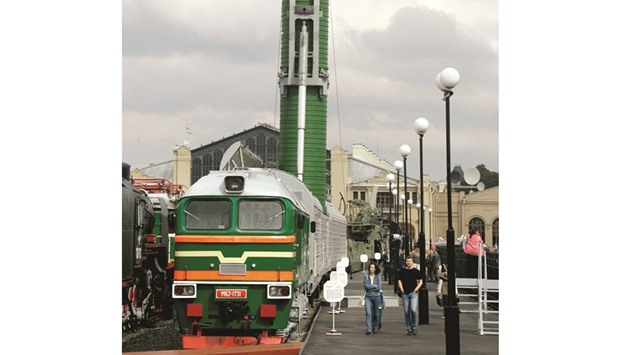Russia’s “ghost train” is coming back. Just like in the grim Soviet-era days, a military train will soon be rolling through Russia’s vast terrain.
It’s not just any kind of train: This one will be loaded with nuclear-tipped missiles, their guidance systems programmed to strike strategic targets in the West.
Amid rising tensions with the West, Russia is flexing its military muscle and so making the international community sit up and take notice.
Military manoeuvres, repositioning ground forces along the western border with the rest of Europe and sending jet fighters to Syria — these are all signs, experts warn, of a “Cold War - Part II” in the making.
In 2014, Moscow’s military doctrine explicitly classified Nato as an opponent. In early 2017, President Vladimir Putin is to be briefed about the development of the train, called Bargusin, with its cargo of five or six missiles. The train was feared by the West back in the 1980s, since it was always on the move and therefore difficult to track.
Russia’s military continued to operate the train into the early 2000s. Now it is to be revived. Interfax reported that the intercontinental missiles had successfully passed their first tests. The train is to be ready for service by 2020.
It was at the Nato summit in Warsaw in July that the gulf between Russia and the West deepened. Russia’s annexation of the Crimean peninsula in 2014 has unsettled Eastern Europe. In Warsaw, Nato agreed to station 1,000 soldiers each in the Baltic states of Latvia, Lithuania and Estonia, as well as in Poland.
In Moscow’s view, Nato crossed a red line with that move. “Nato is an aggressive bloc,” charged Kremlin spokesman Dmitry Peskov. Now Moscow is sending thousands of soldiers to bolster its forces along its western border.
In May, the government decided to create three new divisions, each with 10,000 soldiers.
This sounds like a lot, and yet some argue that it is a sign of weakness on Moscow’s part.
“The West is superior to Russia in every area except the nuclear one,” says military affairs expert Dmitry Trenin of the Carnegie Institute in Moscow. “In such a situation, it is the weaker party that is more ready to take a risk.”
He notes dangerously close aerial encounters between Russian and Western jet fighters over the Baltic Sea. Such encounters have become more frequent in recent months.
If such one of those led to a crash, the situation could escalate into a catastrophe.
Some military observers are sceptical about the western border region build-up.
Since the number of soldiers, by official accounts, in 2016 was scarcely changed, at around 1mn, it most likely means shifting troops out of Central Asia.
And, while the planned 2017 defence budget of around $45bn is big, it is down by about one-quarter from this year.
One place where Russian defence spending is obviously going is the huge bastion-like harbour of Baltijsk near the Baltic Sea exclave of Kaliningrad. Shielded from public view, most of Russia’s fleet in the Baltic is stationed here. The exclave is surrounded by the Nato states of Poland and Lithuania, and so its defence systems are correspondingly equipped.
Recently, the Russian military stationed its anti-ship missile, the Bastion, to beef up its coastal defences. Russia is also building up its presence in Crimea and Syria.
With its S-400 air defence missile, Moscow is establishing a security zone of several hundred kilometres over these areas, making them all but impenetrable for foreign jets.
The Russians have been fighting in Syria for more than a year, longer than initially was expected.
The mission is also regarded as a way of showcasing Russian military technology.
But, for defence expert Trenin, the most important effect is one of gaining respect.
“Russia is behaving in the Middle East in a manner to make it clear to the Americans that it is not merely a regional power, but rather a global power,” he said.
The Kremlin has been flirting with the idea of building up military bases not just in Syria, but also in Vietnam and Cuba – meaning a presence both in the South China Sea and in the Atlantic.
But Moscow has not yet held any official talks with those countries.
“If we compare today’s situation with the Cold War, then we are roughly about where we were at the start of the 1950s,” commented the liberal independent weekly New Times, which is critical of the Kremlin.
“Ahead of us we would still have the Korean crisis and the Cuba crisis,” it added, noting that both those events, had they escalated into a nuclear conflict, could have destroyed the planet.
Today, the world needs more than ever the lesson of history.
“This lesson is called peaceful coexistence,” the publication noted.

Russia’s u201cghost trainu201d called Bargusin, with its cargo of five or six missiles.
